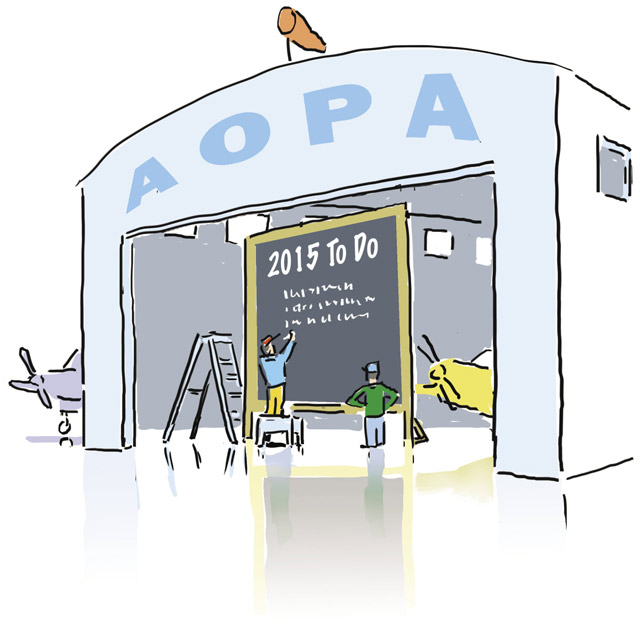Membership News & Notes: Success in 2014
It was a very good year

Illustration by John Holm
This year has been a good one for AOPA’s advocacy team in the states. We worked hard during 2014 to fight off tax increases and reduce the cost of flying—winning sales tax exemptions on maintenance in Missouri and New Mexico, broadening the exemption won last year in Indiana to cover all aircraft in the state, and reducing tax burdens on amateur-built aircraft in Kansas and South Dakota. Over the past two years, AOPA has played a leading role in successfully promoting tax exemptions and defeating tax increases in 19 states, saving aircraft owners and pilots hundreds of dollars annually.
Additionally, we work to keep aviation safe and accessible—winning legislation that ensures appropriate land uses around public-use airports, creating liability protections for private airstrips that are open to the public for recreational use, and requiring the marking and charting of low-altitude tower hazards.
Airport protection remains our top priority as we work to promote and defend the nation’s community airports—too many of which faced threats this year of closure, bad land-use decisions, or operational restrictions. AOPA’s staff worked with more than 2,500 Airport Support Network volunteers and other airport supporters, responding to more than 700 airport issues this year. And 2015 promises more of the same.
SURVEY: 89%of AOPA members believe AOPA is effective in protecting their rights to fly.
2015 To Do list
1. Keep flying affordable
Win more tax exemptions on sales, maintenance, and
parts
Fight fuel-tax increases
2. Keep flying accessible
Fight airport closures
Protect aviation funding
Preserve backcountry airstrips
2015 Fly-In plans
 AOPA is in the process of reviewing the 40 proposals—received from 24 different states—submitted for consideration as locations for AOPA’s Regional Fly-Ins in 2015. The request for proposals (RFP) asked interested airports to describe their airport’s infrastructure, the commitment level of their aviation community, and the interest of their local community in hosting a one-day fly-in event. AOPA’s outreach team, its airport operations staff, and regional managers are considering the proposals. “We are overwhelmed with the enthusiasm of the 40 airports’ proposals,” said Chris Eads, AOPA director of outreach and events. “The hardest part will be picking a handful out of these excellent proposals.” Locations and dates will be chosen by year-end, and announced early in January 2015.
AOPA is in the process of reviewing the 40 proposals—received from 24 different states—submitted for consideration as locations for AOPA’s Regional Fly-Ins in 2015. The request for proposals (RFP) asked interested airports to describe their airport’s infrastructure, the commitment level of their aviation community, and the interest of their local community in hosting a one-day fly-in event. AOPA’s outreach team, its airport operations staff, and regional managers are considering the proposals. “We are overwhelmed with the enthusiasm of the 40 airports’ proposals,” said Chris Eads, AOPA director of outreach and events. “The hardest part will be picking a handful out of these excellent proposals.” Locations and dates will be chosen by year-end, and announced early in January 2015.
AOPA Action: What AOPA is doing to keep you flying
Working together for change
Medical advisory board supports third class reform
The AOPA Medical Advisory Board is the latest group to urge quick action on the proposed FAA rule that would allow thousands more pilots to fly without the need for a third class medical certificate. The group has asked the Department of Transportation and Office of Management and Budget to expedite their reviews of the FAA’s notice of proposed rulemaking (NPRM).
The group’s members, all of whom are pilots and doctors—including several FAA aviation medical examiners (AMEs)—said they believe changing the process will improve safety, save millions of dollars, and keep more pilots in the air. They added that the FAA actually recognized issues with the current medical certification system more than 10 years ago, when it implemented the sport pilot rule, which has allowed thousands of pilots to fly safely without a third class medical certificate.
“Expanding this successful standard will not only save the federal government and general aviation pilots millions of dollars each year, it will also improve safety and foster a more open dialogue with pilots and their personal physicians,” the board wrote.
This is the latest in a series of appeals to speed up the review process so the FAA’s NPRM can be opened for public comment. Similar requests have been made by 11 senators led by John Boozman (R-Ark.) and Jon Tester (D-Mont.), who are co-sponsoring legislation to reform the third class medical process; representatives Todd Rokita (R-Ind.) and Sam Graves (R-Mo.); 32 members of the House General Aviation Caucus; Senate GA Caucus Co-chair Mark Begich (D-Alaska); and a coalition of seven GA industry groups led by AOPA.
Unnecessary pilot stop and searches to decrease
CBP review promises better training and procedures
A promised top-down review of general aviation enforcement practices by Customs and Border Protection’s (CBP) Office of Air and Marine shows that the agency has heard GA concerns, although AOPA will remain vigilant to ensure the rights and freedoms of pilots are respected.
The review cites “opportunities for improvement” and notes that changes have been implemented to increase accountability; improve training; and use CBP personnel, rather than local law enforcement, for stops of GA aircraft. The report also promises that the Office of Air and Marine is taking steps to improve communication with the GA community.
“We’re pleased that CBP’s air and marine division has acknowledged our concerns and recognized the need for change,” said AOPA President Mark Baker. “It is encouraging that they are implementing programs to help ensure agency accountability, improve training, and enhance communication with the general aviation community. Recently, we haven’t seen any more of the egregious, unwarranted stops our members had been reporting, and that’s good news. But we will remain vigilant to ensure that the rights of law-abiding pilots are respected.”
Baker met with CBP Commissioner Gil Kerlikowske earlier this year to object to the unwarranted stops of GA aircraft. Several members of Congress also expressed concern. Kerlikowske promised to deliver a top-down review of the agency’s general aviation enforcement procedures when he was questioned during his confirmation hearing earlier this year.
“We appreciate the leadership of Sen. Pat Roberts (R-Kan.) and Rep. Sam Graves (R-Mo.) on this issue,” Baker added. “They listened to the concerns of the GA community and helped shine a light on questionable practices, paving the way for better relationships between pilots, CBP, and other law enforcement organizations.”
The Office of Air and Marine has implemented a tracking system that requires officers to log all contacts with general aviation pilots in order to reduce the likelihood of repeat unwarranted encounters. But while this system may provide increased accountability within CBP, the records are not subject to Freedom of Information Act requests and cannot be reviewed by the public.
The agency also has made changes to increase the use of CBP officers when making GA stops, rather than depending on local law enforcement officers who may not have experience with GA.
There’s a Spotlight for that
Elevate your flying with ASI’s Safety Spotlights
 Whether you’re eager to sharpen your skills or are preparing for a checkride, the Air Safety Institute has you covered with its online Safety Spotlights, which make it easy to find ASI’s free aviation safety education programs, neatly arranged by subject. There are 20 spotlights that pull together courses, accident case studies, Real Pilot Stories, quizzes, videos, and publications relevant to each topic—from aeromedical to aircraft ownership to runway safety and more. Let’s say your instrument proficiency check is coming up and you want to brush up on the regulations and refresh your knowledge of instrument approach procedures: There’s a spotlight for that. Or perhaps you’ve suffered bouts of mic fright and realize the time has come to improve your communication skills: See the “Radio Communications and ATC” spotlight. There’s something for every experience level—whether certificated pilot, student pilot, flight instructor, or aircraft owner.
Whether you’re eager to sharpen your skills or are preparing for a checkride, the Air Safety Institute has you covered with its online Safety Spotlights, which make it easy to find ASI’s free aviation safety education programs, neatly arranged by subject. There are 20 spotlights that pull together courses, accident case studies, Real Pilot Stories, quizzes, videos, and publications relevant to each topic—from aeromedical to aircraft ownership to runway safety and more. Let’s say your instrument proficiency check is coming up and you want to brush up on the regulations and refresh your knowledge of instrument approach procedures: There’s a spotlight for that. Or perhaps you’ve suffered bouts of mic fright and realize the time has come to improve your communication skills: See the “Radio Communications and ATC” spotlight. There’s something for every experience level—whether certificated pilot, student pilot, flight instructor, or aircraft owner.
Prepared for a winter wonderland?
If you missed ASI’s “Ice Week” in October, there’s still time to learn how to avoid chilly encounters with Mother Nature’s winter weather. You might be especially interested in reviewing Ice Week’s recorded Known Icing, Known Risk webinar, which explores a case study in which a pilot makes a fatal decision to fly during known icing conditions—despite his own analysis and warnings from a weather briefer. Learn how to assess icy conditions in a forecast so you can apply that knowledge before your next flight (www.airsafetyinstitute.org/iceweek).
Ice Week is brought to you by AOPA Insurance Services and VOYA.
New asi seminar coming to your area in January 2015. Visit the website for dates and locations.
On the web: ASI’s Safety Spotlights.
Preflight weather briefings
Do you know the fine print?
 The weather is clear and forecast to be VFR for a quick jaunt to your favorite hamburger joint some 30 miles away. Should you be on record with a preflight weather briefing?
The weather is clear and forecast to be VFR for a quick jaunt to your favorite hamburger joint some 30 miles away. Should you be on record with a preflight weather briefing?
FAR 91.103 requires that you become familiar with “all available” information regarding the flight. But where do you find aviation-specific information about the weather? If you use the FAA Direct User Access Terminal (DUAT) system or a flight service station, you’re on the right track. What if you receive weather information via a third-party provider or a website that offers aviation weather? While this often is the same information provided by DUAT or flight service, the question remains: Will you be on record as having obtained a weather brief prior to going flying?
If your weather briefing (including notams) isn’t recorded or “provable,” it’s difficult to defend yourself if you bust a temporary flight restriction (TFR) or didn’t comply with a notam that had been issued.
Know when your briefing is recorded
• Any call to an FSS briefer is recorded.
• Any briefing obtained through your individual DTC DUAT or CSC DUATS account is recorded.
• Briefings from websites or apps that require unique username and password logins will most likely be recorded.
Download the ASI safety message from the website.
Celebrate your freedom to fly and join other AOPA members who have donated to the AOPA Foundation www.aopafoundation.org/donate. The AOPA Foundation helps fund the work of the AOPA Air Safety Institute.
Pilot Protection Services
Flying with diabetes
How to get your medical back
By Dr. Warren O. Silberman
Diabetes is an increasingly common condition that comes up often for discussion. Diabetes mellitus treated with oral medications or insulin is one of the FAA’s 15 specifically disqualifying medical conditions. These conditions—and there are others beyond the 15—require a special issuance from the FAA, called an AASI, or AME-assisted special issuance.
Diabetes requiring oral medications requires an annual update from your doctor and a current hemoglobin A1c level. Glycated hemoglobin is a form of hemoglobin that is measured primarily to identify the average plasma glucose concentration over prolonged periods of time. Hypoglycemia is a much more dangerous condition than hyperglycemia, or high blood sugar, so the FAA does not want an airman to become hypoglycemic while in flight.
A normal value for HgA1C is usually below 5.7 percent. As I have mentioned, the FAA airman medical exam is not a preventive medicine examination, and for that reason the FAA will allow the A1c level to be as high as 8.9 percent. Beyond that, however, the FAA will deny the airman for poor control.
What does the FAA want to see in this “current status report”? The agency wants the treating physician to comment on when you developed the condition, and what symptoms you were having at the time. Also, the report should include a comment on all the medications you are taking for the diabetes and any other conditions, as well. The physician must note whether you are having any complications from the diabetes, specifically eye disease (called diabetic retinopathy), cardiovascular disease, kidney disease, or neurological conditions. There should also be a note regarding any episodes of low blood sugar (hypoglycemia).
The FAA has created a chart of the common medications used and the acceptable combinations of these medications. Note, however, that the FAA will not grant a special issuance for more than three medications taken concurrently. FAA consultants feel that if an airman needs to take more than three medications, the diabetes is not really adequately controlled for aeromedical certification purposes. Remember that the FAA considers a “current status report” to be no older than 90 days when it is submitted for special issuance consideration.
Dr. Warren O. Silberman is the former manager of FAA Aerospace Medical Certification and a doctor of osteopathic medicine. A pilot since 1986, he is recognized nationally as an expert in aerospace/preventive medicine, and is a regular writer for AOPA’s Pilot Protection Services.
Answers for pilots: Holiday flying: Keeping it merry and bright
As you and your family strap into the airplane, heading for holiday festivities at your daughter and son-in-law’s home, think about what’s running through your mind. Are you running a mental inventory of the gifts packed in the back seats?
Is the cooler keeping their favorite homemade pumpkin pie cold enough? Where is that 2014 “Baby’s First Christmas” ornament for your newest darling?
Stop! You are the pilot in command. Focus on the flying. All of those you love are counting on you to arrive safely.
Read tips for minimizing distraction when flying with family and friends in this month’s Answers for Pilots online.
Do you have flying questions? Give the aviation technical specialists in AOPA’s Pilot Information Center a call. We are available Monday through Friday, 8:30 a.m. to 6 p.m. Eastern Time at 800-USA-AOPA (872-2672).
The FAA has created a chart of the common medications used and the acceptable combinations of these medications.
To learn more about AOPA Pilot Protection Services,visit the website.
Insurance Services
Superior service and pricing, member says
AOPA member says he’d recommend ‘anything AOPA’
A former Navy pilot uses his aircraft to raise awareness about the dangers of addiction. Ron Cuff is proud to be associated with a program called Flight Above Addiction, which uses his 2000 Cessna 182 to “inform communities about teen addiction risk to stop addiction where it starts, before it starts.” As a naval aviator, Cuff landed aboard seven carriers, made 120 traps, and logged some 4,000 hours of flight time.
When it came time to choose insurance for his 182, Cuff selected AOPA for its “superior service and fair pricing.” In fact, he says, “my aircraft insurance with AOPA costs less than my auto policy.” But Cuff goes one step further, saying he would “recommend anything AOPA to any pilot.”
Along with colleague Janet Rowse, Cuff is firmly dedicated to Flights Above Addiction and SafeLaunch. “Young people interested in a career in aviation cannot risk exposure to the disease of addiction. Currently, by my analysis, we are losing about 25 percent of graduating high school seniors to addiction.” he says.
Read more about SafeLaunch online .
No matter what you fly or for what reason, AOPA Insurance has the right policy for you. Don’t forget: You may qualify for a 5-percent discount just for being an AOPA member.
Visit the website to learn about upgrading to the AOPA Premier membership.
For more than 20 years, AOPA Insurance Services has insured more GA aircraft than any other agency in the world. Visit the website or call 877-622-2672 for information on aviation and personal insurance.
Airport Support Network: Closure threat ends for Lost Nation Airport
The threat of closure is over for Willoughby-Lost Nation Municipal Airport in Willoughby, Ohio, after supporters made the case to local officials that the airport provides value to the local economy. Ownership was transferred from municipal control to Lake County and a regional economic development authority.
Pilots often had to struggle to be heard in the long campaign to save the airport, said Gary Swanson, a local businessman, pilot, and AOPA’s Airport Support Network volunteer at the airport. But when supporters outside the aviation community, including business leaders, stepped up to confirm that the airport gives them a competitive edge, it opened the door to discussions that led to a solution.


